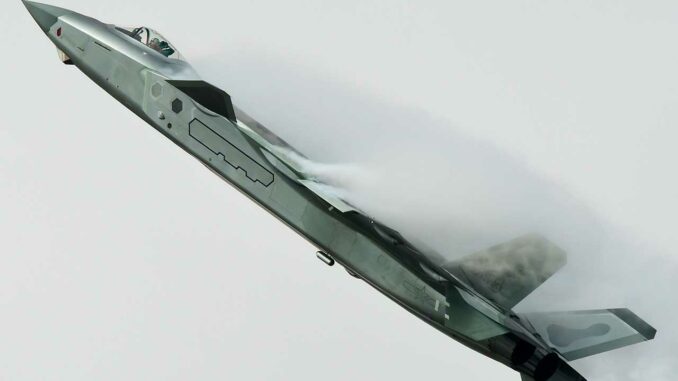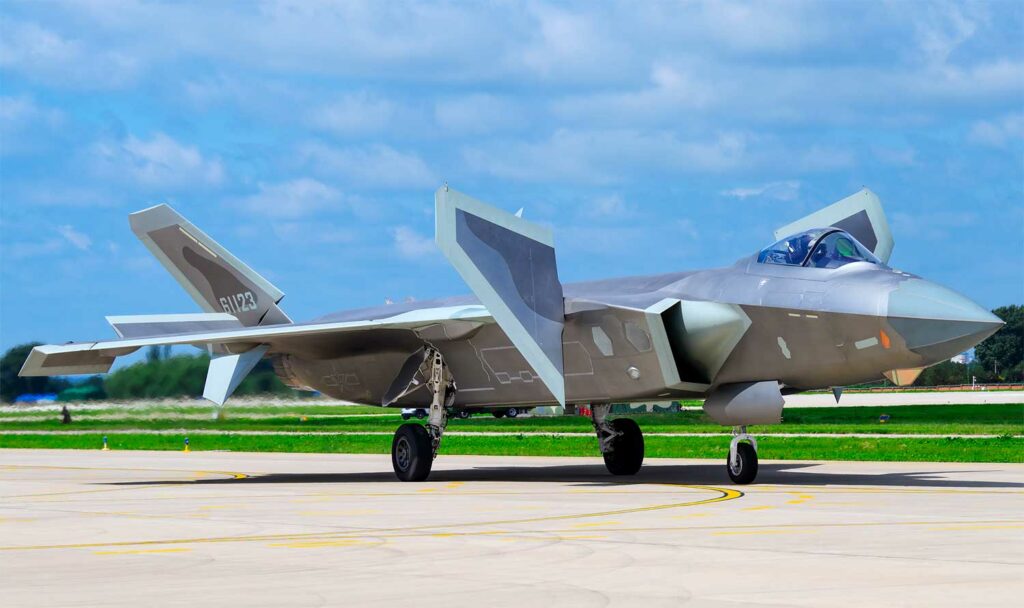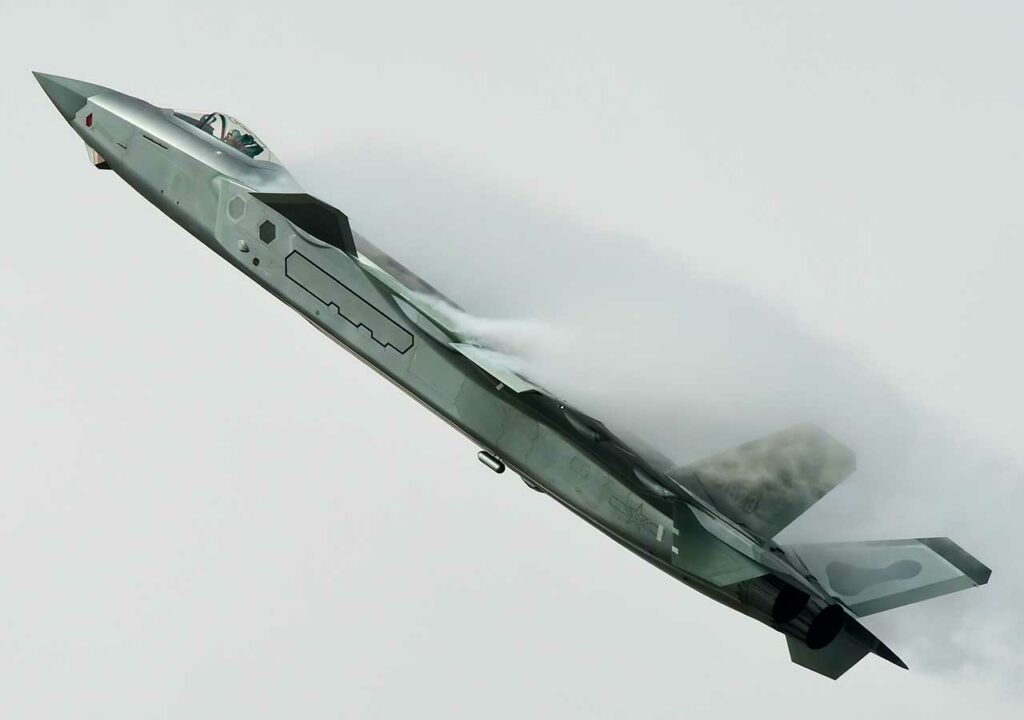
China is strengthening its air power with the J-20, J-16, and J-10C, the technological pillars of a rapidly modernizing fighter fleet.
The People’s Liberation Army (PLA), through its air force, is pursuing an accelerated modernization program. The trio of J-20, J-16 and J-10C aircraft now represents the operational backbone of the combat capabilities of the Chinese Air Force (PLAAF). These three platforms, each integrated into a well-defined tactical role, enable Beijing to strengthen its regional superiority against adversaries such as Japan, Taiwan and the United States.
The J-20, considered China’s first fifth-generation stealth fighter jet, has reached several milestones since entering service in 2017. It now serves as the backbone of long-range deterrence operations. The J-16, an upgraded version of the Russian Su-30, acts as a multi-role combat aircraft with enhanced offensive capabilities. Finally, the J-10C, which is lighter and more versatile, performs air superiority, interdiction, and tactical support missions.
The integration of these aircraft into a centralized digital command system, coupled with the rise of electronic warfare capabilities and local engine production, marks a clear break with past technological dependence. This dynamic is transforming the PLAAF into a force capable of conducting large-scale offensive campaigns within a radius of more than 1,500 kilometers.

A fifth-generation fighter: the central role of the Chengdu J-20
The Chengdu J-20 is the most advanced aircraft in the Chinese arsenal. Developed by the Chengdu Aircraft Corporation, it was designed to rival the American F-22 Raptor and F-35 Lightning II. Since 2017, the PLAAF has integrated it into several elite brigades. It is estimated that more than 250 units are already operational or in the process of being deployed.
The J-20 is a large Chinese stealth fighter jet capable of operating at very high altitudes and long ranges. It features stealth air intakes, radar-absorbing coatings (RAM), and a delta-canard configuration that reduces its frontal radar signature. It is approximately 21 meters long, with a wingspan of 13 meters. Its operational range is said to exceed 1,500 km, allowing it to strike deep into the Pacific beyond the first island chain.
Until 2021, the J-20 used Russian AL-31F engines. Since then, China has equipped its aircraft with locally produced WS-10C engines, which offer a better thrust-to-weight ratio and facilitate high-speed maneuvers. The development of the WS-15, which is said to achieve a thrust of over 180 kN, is in an advanced testing phase and could enable a supercruise mode without afterburner.
The J-20’s onboard equipment includes a latest-generation AESA radar, advanced electronic warfare capabilities, and a secure data link system. It can carry PL-15 long-range (over 300 km) and PL-10 short-range missiles, housed in internal bays to preserve its stealth.
Its main function is breaching contested airspace, with the support of drones or other fighters. Its role as an “air quarterback,” i.e., a network-centric combat coordinator, makes it a force multiplier in an operational theater.
The Shenyang J-16, a heavy multi-role offensive platform
The Shenyang J-16 is based on the airframe of the Su-30MKK, a derivative of the Russian Su-27 acquired in the early 2000s. This model has been significantly modified by China. Manufactured by Shenyang Aircraft Corporation, the J-16 is a Chinese 4.5-generation fighter jet capable of striking ground, sea, and air targets with a varied arsenal.
With a maximum takeoff weight of over 35 tons, a range exceeding 1,500 kilometers, and the ability to carry more than 8 tons of ammunition, the J-16 is designed for long-range missions. It is now equipped with AESA radar, onboard jammers, and infrared sensors. The most recent version includes radar-absorbing paint, which partially reduces its visibility.
The J-16 is generally deployed in coastal areas of the South China Sea or at bases in the Eastern Theater, in support of tensions around Taiwan. It can carry YJ-83 anti-ship missiles, LS-6 guided bombs, and PL-15 air-to-air missiles. As a tactical bomber, it is a key component in large-scale air offensives.
More than 250 aircraft are believed to be in active service. The army uses them in conjunction with the J-20 for coordinated operations: the J-20 opens the attack corridor in a saturated environment, while the J-16 strikes with its heavy payload from behind.
The existence of a two-seater version, used for electronic warfare or tactical coordination, further enhances its flexibility. Loyal Wingman-type drones could soon be integrated, further enhancing its distributed strike capability.
The Chengdu J-10C, a modernized light fighter for regional superiority
The J-10C is the latest evolution of the J-10 program, which first flew in the late 1990s. Produced by Chengdu Aircraft Corporation, this platform is the lightest of the three, with a maximum takeoff weight of approximately 19 tons and a length of 17 meters. It is used in more than 10 PLAAF brigades, with an estimated fleet of approximately 300 to 350 aircraft.
The C version incorporates a KLJ-7A AESA radar, an onboard electronic warfare system, infrared sensors, and a digital cockpit compatible with integrated vision helmets. The WS-10B engine powers the J-10C with sufficient thrust for high-angle maneuvers.
This Chinese light fighter provides air defense, strike interdiction, and escort for other aircraft. It is capable of carrying PL-15 and PL-10 missiles, Beidou guided bombs, and reconnaissance pods.
The J-10C is also the model of choice for export. Pakistan has ordered 50 J-10CEs, a version adapted to the needs of the Pakistani army, to be delivered in 2022 and 2023. Other countries could follow suit, as China is offering these aircraft at around $35 million each, a competitive price compared to Western models.
In the Chinese tactical structure, the J-10C is often used as an interception or routine patrol aircraft, supporting forward air bases. It is also frequently engaged in joint maneuvers, demonstrating its ability to operate in a connected environment with other aircraft.

An offensive doctrine supported by technological integration
Beyond these platforms, the PLAAF integrates its aircraft into a comprehensive tactical network, combining encrypted communications, sensor sharing, electronic warfare, and unified command. Satellites, ground-based radars, and drones are all part of this combat architecture.
The concept of a “system of systems” applies here in full: each aircraft becomes a node in a global network, capable of merging data with land, sea, and air assets. The J-20, in particular, acts as a communications relay with drones such as the WZ-7 and H-6K bombers.
This logic transforms the PLAAF into a long-range regional interdiction force, capable of projecting its power as far as the second island chain (beyond Guam), while maintaining constant pressure on the enemy’s front lines. The challenge to US and Japanese forces is becoming real.
War Wings Daily is an independant magazine.